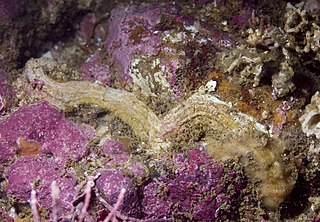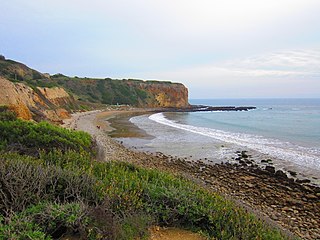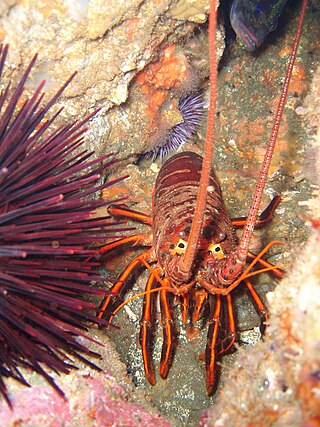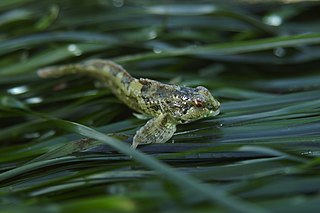
A tide pool or rock pool is a shallow pool of seawater that forms on the rocky intertidal shore. These pools typically range from a few inches to a few feet deep and a few feet across. Many of these pools exist as separate bodies of water only at low tide, as seawater gets trapped when the tide recedes. Tides are caused by the gravitational pull of the sun and moon. A tidal cycle is usually about 25 hours and consists of one or two high tides and two low tides.

The intertidal zone or foreshore is the area above water level at low tide and underwater at high tide: in other words, the part of the littoral zone within the tidal range. This area can include several types of habitats with various species of life, such as seastars, sea urchins, and many species of coral with regional differences in biodiversity. Sometimes it is referred to as the littoral zone or seashore, although those can be defined as a wider region.

A surge channel is a narrow inlet, usually on a rocky shoreline, and is formed by differential erosion of those rocks by coastal wave action. As waves strike the shore, water fills the channel, and drains out again as the waves retreat. The narrow confines of the channel create powerful currents that reverse themselves rapidly as the water level rises and falls, and cause violent hydrodynamic mixing. However, there is relatively little exchange of water between channels; experimental studies and mathematical modelling of the coastline near Hopkins Marine Station in California have shown that water is rapidly mixed within each channel, but that it mostly moves in an oscillatory manner. Surge channels have been likened to 'containment vessels', retaining water borne gametes and probably enhancing the effectiveness of external fertilisation of marine species dwelling within them.

Thylacodes squamigerus, common name the scaled wormsnail, is a species of sea snail, a marine gastropod mollusk in the family Vermetidae, the worm snails. This species was previously known as Serpulorbis squamigerus.

Seashore wildlife habitats exist from the Tropics to the Arctic and Antarctic. Seashores and beaches provide varied habitats in different parts of the world, and even within the same beach. Phytoplankton is at the bottom of some food chains, while zooplankton and other organisms eat phytoplankton. Kelp is also autotrophic and at the bottom of many food chains. Coastal areas are stressed through rapid changes, for example due to tides.

Goniobranchus vibratus, common name trembling nudibranch, is a species of colourful sea slug, a dorid nudibranch, a marine gastropod mollusc in the family Chromodorididae.

Abalone Cove State Marine Conservation Area (SMCA) and Point Vicente State Marine Reserve (SMR) are two adjoining marine protected areas that extend offshore in Los Angeles County on California's south coast. The two marine protected areas cover 19.87 sq mi (51.5 km2). The marine protected areas protect natural habitats and marine life by protecting or limiting removal of wildlife from within their boundaries. Point Vicente SMR, prohibits all take of living marine resources. Abalone Cove SMCA, prohibits take of all living marine resources, except recreational take of pelagic finfish, including Pacific bonito and white seabass by spearfishing, market squid by hand-held dip net, commercial take of coastal pelagic species and Pacific bonito by round haul net, and swordfish by harpoon.

Paraclinus integripinnis, the reef finspot, is a species of labrisomid blenny native to the Pacific coast of North America from southern California to Baja California. This species inhabits rocky areas and tide pools down to depths of 15 metres (49 ft). It can reach a length of 6.4 centimetres (2.5 in) TL.

Crystal Cove State Marine Conservation Area (SMCA) is one of a cluster of four adjoining marine protected areas that extend offshore of Newport Beach in Orange County on California’s south coast. The SMCA covers 3.45 square miles of near shore waters. Crystal Cove protects marine life by limiting the removal of marine wildlife from within its borders, including tide pools. Take of all living marine resources is prohibited except: recreational take of finfish by hook-and-line or by spearfishing, and lobster and sea urchin is allowed. Commercial take of coastal pelagic species by round haul net, spiny lobster by trap, and sea urchin is allowed.

Dana Point State Marine Conservation Area

Aglaophenia is a genus of hydrozoans in the family Aglaopheniidae.
Doto awapa is a species of sea slug, a nudibranch, a marine gastropod mollusc in the family Dotidae.

Doto floridicola is a species of sea slug, a nudibranch, a marine gastropod mollusc in the family Dotidae.

Doto columbiana is a species of sea slug, a nudibranch, a marine gastropod mollusc in the family Dotidae.
Doto lancei is a species of sea slug, a nudibranch, a marine gastropod mollusc in the family Dotidae.

Dendronotus subramosus is a species of sea slug, a dendronotid nudibranch, a shell-less marine gastropod mollusc in the family Dendronotidae.

The tidepool sculpin is a fish species in the sculpin family Cottidae that ranges from the Bering Sea to southern California. Individuals reach up to 8 cm (3 in) in length and are common in tidepools.

The fluffy sculpin or Lizard Fish is a fish species in the sculpin family Cottidae. It inhabits the coastal northwestern Pacific Ocean, ranging from Kodiak, Alaska to Baja California (Mexico). Individuals reach up to 9 cm (3.5 in) in length, and are commonly found in tidepools, often associated with algae.
Feathery hydroid is a common name for several hydroids and may refer to:
















